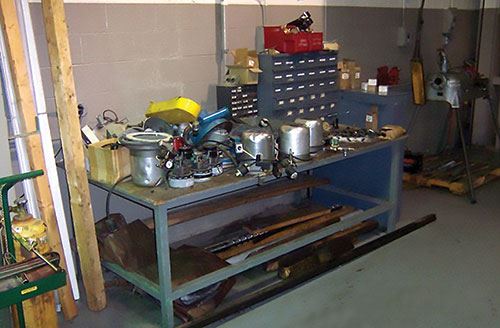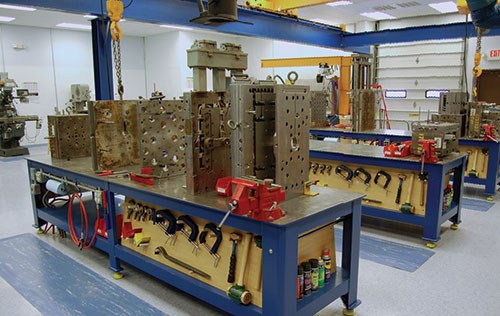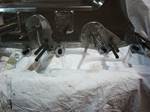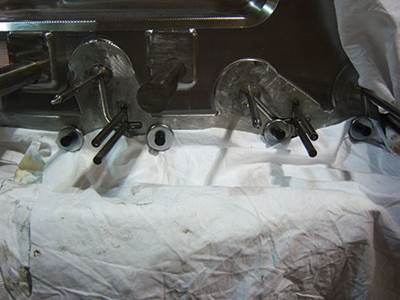Designing the Perfect Mold Repair Bench
The right tools and working environment can help you complete a job more easily and more efficiently.
Maintaining a fleet of molds in a timely and efficient manner is a support function, and the bench is a critical part of the mold maintenance process. However, this is also a piece of equipment that is given not so much as a second thought by many companies, and I’ve seen plenty of examples of this all over the world.
On the Floor?
Having conducted maintenance capabilities assessments on four continents, I’ve seen some interesting setups. For example, in China the mold benches, if they exist, are typically low to the floor and require the mold repair technician to squat like a baseball catcher to work on the molds. In the absence of benches, the technicians work on small molds directly on the floor.
I’ve also seen benches that resemble the tables at your favorite bistro or pub. They were often too tall, too short or set up in an inefficient manner with no particular ergonomic specification. There were benches with tops so beaten up and uneven that mold plates could not stand on them safely without support. Some benches had tops made from granite surface plates that were 4 feet wide, 10 feet long and 12 inches thick. There were also benches with solid wood tops, plastic laminate tops and stainless steel “covers.”
In all of these examples, it was evident that the mold bench was not planned out as a work cell or designed so the technician could efficiently work on molds that needed to return as quickly as possible to the molding machine. Too often, the mold maintenance and repair bench is a hand-me-down or an afterthought, and it is not designed for its intended use.
Efficiency = Profitability
The molder’s mantra is “efficiently produce quality parts on time.” Mold maintenance and its efficiency is an important element for accomplishing that goal. We only make money when the molds are running and producing quality parts.
The bench design, construction and placement are all crucial to a mold shop’s ability to efficiently work on molds. Following is a list of common problems with the makeup of mold repair benches:
• Bench tops are not flat or level.
• Benches are too short or too tall.
• Benches are on wheels.
• There are no leveling feet on the benches.
• There is no bottom shelf, or the shelf is too close to the floor so you can’t clean underneath it.
• There is no vise on the bench.
• Benches are left unpainted, complicating upkeep and reducing the “cleanliness” factor.
• Utilities are only accessible from above the floor, so electrical cords, water lines and air hoses are draped over and around the benches, creating tripping hazards.
• Overhead lighting is significantly less than recommended for visual inspection of molds, which is critical in the troubleshooting stage of a mold repair.
• There is limited access to or no overhead hoist for separating molds on the bench or for moving plates safely.
• Common hand tools, such as clamps, die bars, eye bolts, etc., are not stored under the mold bench on shadow boards for easy access. Instead they are kept on a “community tool board” or scattered around the shop, which causes a lot of wasted time as technicians must run around to find them.
• In the case of multiple benches, they are not spaced correctly, and this is critical.
• Team members are not assigned to a particular bench and as a result there is no accountability or ownership of that bench, which promotes inefficient operations.
The Ideal Bench Setup
The ideal bench design for mold maintenance should be 36 inches wide (allowing a technician to reach across to retrieve something instead of walking around), 12 feet long and 34 inches tall (for molds that are 36 inches tall, at most). To accommodate taller molds, consider lowering the bench top.
For molds that weigh 3 tons or less, bench top thickness can be 0.375 inch to provide appropriate support. Tops should be Blanchard-ground for smoothness and flatness, a bottom shelf should be positioned about 6 inches from the floor, and utilities (electric, air, water and a drain) should be trenched under the floor and safely within the technician’s reach.
A monorail crane system with a dedicated beam and hoist over each bench provides quick and equal access. Some shops have bridge cranes, but the wait time to use them is longer, they are rarely centered over the benches and they can have complicated control panels.
Lighting over the benches should be no less than 75 foot-candles to provide proper visual inspection capability.
To keep waste from getting on or in a mold, bench placement away from machinery that produces chips and creates dust and lighter-debris waste streams is critical. Spacing between benches should be 4 feet or more, depending on mold size and position.
Bench Care
Just like the molds that sit on them, benches require routine care and maintenance. It’s recommended that bench tops are flat-stoned and deburred on a regular basis. This eases sliding of the mold plates and prevents sharp edges that could injure a technician. Use a disc sander periodically and a medium Norton stone daily to smooth the surface after working on molds. This also ensures the mold plates will continue to slide easily across the bench surface. Applying a rust preventative to the bench top to seal the surface is also recommended. The bench frame should also be painted for protection.
The floor under and around the bench should also be a consideration. Invest in mats designed to reduce mold repair technician fatigue. Some mats are designed to catch flying chips, debris and fluids, which may affect mold cleaning. Smooth mats are a better choice as they won’t trap the chips and debris, and their tapered edges won’t inhibit carts or present a tripping hazard.
Summary
The mold bench is a repair technician’s office, so addressing these bench considerations can help or hinder the technician’s effectiveness and efficiency. Standardization and systemization can help create a work cell for the primary purpose of mold maintenance that in the end will help molders “efficiently produce quality parts on time.”
Related Content
Hands-on Workshop Teaches Mold Maintenance Process
Intensive workshop teaches the process of mold maintenance to help put an end to the firefighting culture of many toolrooms.
Read More5 Hot Runner Tips for Moldmakers and Molders
Best practices for initial hot runner tryouts and effective preventive maintenance.
Read MoreWhat is Scientific Maintenance? Part 2
Part two of this three-part series explains specific data that toolrooms must collect, analyze and use to truly advance to a scientific maintenance culture where you can measure real data and drive decisions.
Read MoreQuestions and Considerations Before Sending Your Mold Out for Service
Communication is essential for proper polishing, hot runner manifold cleaning, mold repair, laser engraving and laser welding services.
Read MoreRead Next
In the Trenches: I Need a Crash Cart in Here
A look at what you may want to stock in your facility’s “crash cart” to respond appropriately to press emergencies.
Read MoreReasons to Use Fiber Lasers for Mold Cleaning
Fiber lasers offer a simplicity, speed, control and portability, minimizing mold cleaning risks.
Read MoreAre You a Moldmaker Considering 3D Printing? Consider the 3D Printing Workshop at NPE2024
Presentations will cover 3D printing for mold tooling, material innovation, product development, bridge production and full-scale, high-volume additive manufacturing.
Read More





















